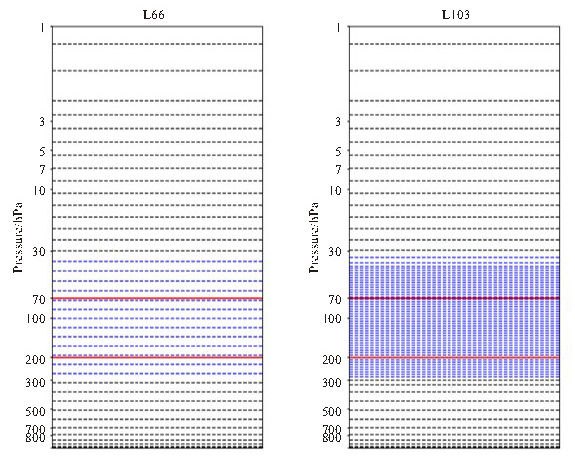Impact of Vertical Resolution on ENSO Teleconnection Simulation
-
摘要: 模式分辨率对气候模式的模拟效果具有重要影响。然而,当前模式开发对于垂直分辨率的重视不够。以ENSO(厄尔尼诺-南方涛动)遥相关为例,利用CESM(Community Earth System Model)模式,探究不同模式垂直分辨率设置下模式模拟的ENSO对平流层、对流层影响的差异,评估模式垂直分辨率在气候模拟中的重要性。结果表明,提高垂直分辨率可以显著改进模式对ENSO遥相关的模拟能力。以ECMWF(European Centre for Medium-Range Weather Forecasts)第五代再分析数据集(ERA5)为参照,ENSO对纬向平均温度的影响在北半球中高纬地区冬季呈现出“负正负”的三极子模态。CESM默认的垂直分辨率设置(L66)不能模拟出这一模态,而提高模式垂直分辨率(L103)后则可以较好地模拟出这个模态。对于水平分布而言,L66模拟的ENSO在对流层的信号与再分析资料相比明显偏强,L103则可以显著改善。同时,L103对ENSO影响平流层的模拟效果也比L66有所改善。进一步分析发现,L103模拟的行星波从对流层向平流层的传播更强,更接近再分析资料。提高垂直分辨率可以改善模式对大气波活动以及平流层-对流层动力耦合的模拟,重视模式的研发。Abstract: Model resolution significantly influences the simulation effect of climate models. However, model vertical resolution has not been a primary focus in current model development. To evaluate the importance of model vertical resolution in climate modeling, this study took the El Niño-Southern Oscillation (ENSO) teleconnection as an example and explored the impact of different vertical resolution settings in the Community Earth System Model (CESM) on the simulation of ENSO teleconnections in the stratosphere and the troposphere. The results show that increasing vertical resolution can significantly boost the model's capability to simulate ENSO teleconnection. Based on the fifth generation reanalysis (ERA5) dataset from the European Centre for Medium-Range Weather Forecasts, the present study explored the effect of ENSO on zonal mean temperature and found a'negative-positive-negative'tripole mode in winter over the mid-to-high latitudes in the Northern Hemisphere. The CESM model with default vertical resolution (66 vertical levels, L66) failed in simulating this mode, while the model with higher vertical resolution (103 vertical levels, L103) performed better in capturing this mode. For the horizontal distribution of ENSO teleconnection, the tropospheric signal of ENSO simulated by L66 was stronger than that indicated by the reanalysis data, whereas the signal in L103 was significantly improved. The L103 model also simulated a more accurate ENSO teleconnection in the stratosphere compared to L66. Further analysis shows that the planetary waves simulated by L103 propagated more robustly from the troposphere to the stratosphere, which was more consistent with the ERA5 reanalysis data. Overall, improving vertical resolution can significantly improve the simulation of atmospheric wave activities and the stratospheretroposphere dynamic coupling, which should be prioritized in model development.
-
表 1 试验设置
模式 垂直层数 时间范围/年 集合成员(模拟数量) Run_L66 66 1951—2010 1 Run_L103 103 1951—2010 1 ENS6L66 66 2001 6 FS6L66 66 1991—2001 6 ENS6L103 103 2001 6 FS6L103 103 1991—2001 6 -
[1] MCPHADEN M J, BUSALACCHI A J, CHENEY R, et al. The Tropical Ocean-Global Atmosphere observing system: A decade of progress [J]. J Geophys Res, 1998, 103: 14169-14240. [2] LEE T, MCPHADEN M J. Increasing intensity of El Niño in the central-equatorial Pacific[J]. Geophys Res Lett, 2010, 37(14): L14603. [3] XIE F, LI J, TIAN W, et al. Signals of El Niño Modoki in the tropical tropopause layer and stratosphere[J]. Atmos Chem Phys, 2012, 12(2): 5259-5273. [4] JIN F F, AN S I. TIMMERNANN A. Strong EL Niño events and nonlinear dynamical heating[J]. Geophys Res Lett, 2003, 30(3): 20-21. [5] FENG J, CHEN W, LI Y. Asymmetry of the winter extra-tropical teleconnections in the Northern Hemisphere associated with two types of ENSO[J]. Climate Dyn, 2017, 48(7-8): 2135-2151. [6] WANG C. A review of ENSO theories[J]. Natl Sci Rev, 2018, 5(6): 813-825. [7] FANG X, XIE R. A brief review of ENSO theories and prediction[J]. Sci China Earth Sci, 2020, 63(4): 476-491. [8] BELLENGER H, GUILYARDI E, LELOUP J, et al. ENSO representation in climate models: from CMIP3 to CMIP5[J]. Climate Dyn, 2014, 42(8): 1999-2018. [9] OKUMURA Y M. ENSO Diversity from an Atmospheric Perspective[J]. Internatind Climate Variability, 2019, 5(3): 245-257. [10] YAN Z, WU B, LI T, et al. Mechanisms Determining Diversity of ENSO-Driven Equatorial Precipitation Anomalies[J]. J Climate, 2022, 35(3): 923-939. [11] MCPHADEN M J, ZEBIAK S E, GLANTZ M H. ENSO as an integrating concept in earth science[J]. Science, 2006, 314(5806): 1740-1745. [12] 任福民, 袁媛, 孙丞虎, 等. 近30年ENSO研究进展回顾[J]. 气象科技进展, 2012, 2(3): 17-24. [13] 赵树云, 陈丽娟, 崔童. ENSO位相转换对华北雨季降水的影响[J]. 大气科学, 2017, 41(4): 857-868. [14] ZHAO S, ZHANG H, XIE B. The effects of El Niño-Southern Oscillation on the winter haze pollution of China[J]. Atmos Chem Phys, 2018, 18(3): 1863-1877. [15] CAI W, WU L, LENGAIGNE M, et al. Pantropical climate interactions[J]. Science, 2019, 363(6430): 11. [16] XUE A, JIN F F, ZHANG W, et al. Delineating the seasonally modulated nonlinear feedback onto ENSO from tropical instability waves[J]. Geophys Res Lett, 2020, 47(7): e2019GL085863. [17] GARFINKEL C I, HARTMANN D L. Effects of the El Niño-Southern Oscillation and the Quasi-Biennial Oscillation on polar temperatures in the stratosphere[J]. J Geophys Res, 2007, 112: D19112. [18] CALVO N, GARCIA-HERRERA R, GARCIA R R. The ENSO Signal in the Stratosphere[J]. Analysis of the New York Academy of Sciences, 2008, 1146(1): 16-31. [19] INESON S, SCAIFE A. The role of the stratosphere in the European climate response to El Niño[J]. Nature Geosci, 2009, 2(1): 32-36. [20] MANZINI E. ENSO and the stratosphere[J]. Nature Geosci, 2009, 2(11): 749-750. [21] BALDWIN M P, O'SULLIVAN D. Stratospheric effects of ENSO-related tropospheric circulation anomalies[J]. J Climate, 1995, 8(4): 649-667. [22] FRANZKE C, FELDSTEIN S B. The continuum and dynamics of Northern Hemisphere teleconnection patterns[J]. J Atmos Sci, 2005, 62(9): 3250-3267. [23] SMITH K L, KUSHNER P J. Linear interference and the initiation of extratropical stratosphere-troposphere interactions[J]. J Geophys Res, 2012, 117: D13107. [24] STAN C, STRAUS D M, FREDERIKSEN J S, et al. Review of tropical-extratropical teleconnections on intraseasonal time scales[J]. Rev Geophys, 2017, 55(D9): 902-937. [25] BARRIOPEDRO D, CALVO N. On the Relationship between ENSO, Stratospheric Sudden Warmings, and Blocking[J]. J Climate, 2014, 27(12): 4704-4720. [26] JOHNSON N C, FELDSTEIN S B. The continuum of North Pacific Sea level pressure patterns: Intraseasonal, interannual, and interdecadal variability[J]. J Climate, 2010, 23(4): 851-867. [27] CAPOTONDI A, WITTENBERG A T, NEWMAN M, et al. Understanding ENSO Diversity[J]. Bull Am Meteorol Soc, 2015, 96(6): 921-938. [28] MARSH D R, MILLS M J, KINNISON D E, et al. Climate change from 1850 to 2005 simulated in CESM1(WACCM) [J]. J Climate, 2013, 26(19): 7372-7391. [29] 史湘军, 刘娇娇, 朱寿鹏, 等. 基于CMIP6强迫模拟分析人为气溶胶的气候效应(二)——诊断方法在分类评估中的重要性[J]. 大气科学学报, 2020, 43(4): 630-639. [30] ZHOU B Q, ZHAI P M. Climate constraint prediction methods in the IPCC 6th Climate Change Assessment[J]. Acta Meteor Sinica, 2021, 79(6): 1063-1070. [31] 吴统文, 宋连春, 李伟平, 等. 北京气候中心气候系统模式研发进展——在气候变化研究中的应用[J]. 气象学报, 2014, 72(1): 12-29. [32] HE Y, ZHU X, SHENG Z, et al. Observations of inertia gravity waves in the Western Pacific and their characteristic in the 2015/2016 quasi‐ biennial oscillation disruption[J]. J Geophys Res Atmos, 2022, 127: e2022JD037208. [33] LU Y, TANG J, WANG Y, et al. Validation of near-surface winds obtained by a Hybrid Wrf / Calmet modeling system over a coastal island with complex terrain[J]. J Trop Meteorol, 2012, 18(3): 284-296. [34] 郜倩倩, 刘煜, 郭增元, 等. 气候模式分辨率对气溶胶气候效应模拟结果的影响[J]. 气象学报, 2022, 80(4): 515-532. [35] LU Y, WU T, XU X, et al. Improved simulation of the Antarctic stratospheric final warming by modifying the orographic gravity wave parameterization in the Beijing Climate Center Atmospheric General Circulation Model[J]. Atmosphere, 2020, 11(6): 576. [36] WU T, YU R, LU Y, et al. BCC-CSM2-HR: a high-resolution version of the Beijing Climate Center Climate System Model[J]. Geoscientific Model Developwent, 2021, 14(5): 2977-3006. [37] HACK J, CARON J, DANABASOGLU G, et al. CCSM-CAM3 climate simulation sensitivity to changes in horizontal resolution[J]. J Climate, 2006, 19(11): 2267-2289. [38] DEMORY M E, VIDALE P L, ROBERTS M J, et al. The role of horizontal resolution in simulating drivers of the global hydrological cycle [J]. Climate Dyn, 2014, 42(7-8): 2201-2225. [39] RIND D, LERNER J, JONAS J, et al. Effects of resolution and model physics on tracer transports in the NASA Goddard Institute for Space Studies general circulation models[J]. J Geophys Res, 2007, 112: D09315. [40] ROECKNER E, BROKOPF R, ESCH M, et al. Sensitivity of simulated climate to horizontal and vertical resolution in the ECHAM5 Atmosphere Model[J]. J Climate, 2006, 19(16): 3771-3791. [41] JUNG T, MILLER M J, PALMER T N, et al. High-Resolution Global Climate Simulations with the ECMWF Model in Project Athena: Experimental Design, Model Climate, and Seasonal Forecast Skill[J]. J Climate, 2012, 25(9): 3155-3172. [42] BIRNER T. Fine-scale structure of the extratropical tropopause region[J]. J Geophys Res, 2006, 111: D04104. [43] WANG W, MATTHES K, SCHMIDT T, et al. Recent variability of the tropical tropopause inversion layer[J]. Geophys Res Lett, 2013, 40(23): 6308-6313. [44] WANG W, SHANGGUAN M, TIAN W, et al. Large uncertainties in estimation of tropical tropopause temperature variabilities due to model vertical resolution[J]. Geophys Res Lett, 2019, 46(16): 10043-10052. [45] CHAVEZ V, ANEL J, GARCIA R, et al. Impact of increased vertical resolution in WACCM on the cimatology of major sudden stratospheric warmings[J]. Atmosphere, 2022, 13(4): 546. [46] RICHTER J H, SOLOMON A, BACMEISTER J T. Effects of vertical resolution and nonorographic gravity wave drag on the simulated climate in the Community Atmosphere Model, version 5[J]. Jaurnal of Advances in Modeling Earth Systems, 2014, 6(2): 357-383. [47] XIE F, ZHANG J, LI X, et al. Independent and joint influences of eastern Pacific El Niño-Southern oscillation and quasi-biennial oscillation on Northern Hemispheric stratospheric ozone[J]. Int J Climatol, 2020, 40(12): 5289-5307. [48] ZHANG J, TIAN W, WANG, et al. The Influence of ENSO on Northern Midlatitude Ozone during the Winter to Spring Transition[J]. J Climate, 2015, 28(12): 4774-4793. [49] HERSBACH H, BELL B, BERRISFORD P, et al. The ERA5 global reanalysis[J]. Quart J Roy Meteor Soc, 2020, 146(730): 1999-2049. [50] GETTELMAN A, BIRNER T. Insights into Tropical Tropopause Layer processes using global models[J]. J Geophys Res, 2007, 112: D23104. [51] 黎颖, 王欣, 马楚楚. 汉江流域暴雨的Eliassen-Palm通量特征及潜势预报[J]. 陕西气象, 2020(5): 11-15. [52] 施春华, 徐婷, 蔡娟, 等. 球面E-P通量的计算及其应用[J]. 大气科学学报, 2015, 38(2): 267-272. [53] 陈新强. 近年来谐波天气分析在我国的进展[J]. 气象科技, 1983, 2(3): 14-23. [54] CHEN M, LI T. ENSO evolution asymmetry: EP versus CP El Niño[J]. Climate Dyn, 2021, 56(11-12): 1-11. [55] XIE F, ZHOU X, LI J, et al. Effect of the Indo-Pacific Warm Pool on Lower-Stratospheric Water Vapor and Comparison with the Effect of ENSO[J]. J Climate, 2018, 31(3): 929-943. [56] DOMEISEN D I, GARFINKEL C I, BUTLER A H. The teleconnection of El Niño Southern Oscillation to the stratosphere[J]. Rev Geophys, 2019, 57(1): 5-47. [57] WATSON P, GRAY L. How does the quasi-biennial oscillation affect the stratospheric polar vortex? [J] J Atmos Sci, 2014, 71(1): 391-409. [58] 兰晓青, 陈文, 王林. 北半球平流层准定常行星波与平均流的相互作用及其对ENSO事件的响应[J]. 中国科学: 地球科学, 2012, 42(1): 10-23. -






 下载:
下载:












 粤公网安备 4401069904700003号
粤公网安备 4401069904700003号